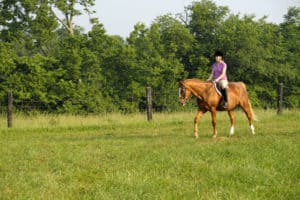
Exercise Benefits Senior Horses
Age-related issues can limit performance, but regular exercise remains important for older horses.

Age-related issues can limit performance, but regular exercise remains important for older horses.
Overfeeding these horses can cause them more harm than good. The best initial feed is often good-quality hay.
A better equine feeding system will offer small amounts of grain and forage over many hours.
Various supplements are commonly given to breeding stallions in hopes of improving semen quality, but conflicting reports exist on their effectiveness. Researchers have found, however, that the supplement ingredient DHA, an omega-3 fatty acid found in fish oil, does have a positive effect on semen quality.
Every horseperson has seen the telltale signs of a thin horse: the disproportionately skinny neck, the protruding spine, the row of ribs, and the jutting hipbones. Thanks in part to advances made in feeding management, veterinary care, parasite control, and dentistry, educated caretakers can fatten horses safely and easily. But when is it time to switch from a “weight-gain” diet to a “maintenance”
The capacity of feeds and forages to counteract changes in gastric pH (their buffering capacity) plays an important role in the prevention of gastric ulcers in horses. Alfalfa hay has been shown to be more effective in reducing the severity of ulcers in horses by providing superior buffering capacity compared to grass hay.
In many parts of the world horse pastures contain a fair percentage of fescue, a hardy perennial grass that thrives despite heavy hoof traffic, intense grazing, and adverse growing conditions. Unfortunately, there’s a drawback: 75% of all fescue is infected with the endophyte Acremonium coenophialum.
During the colder months, many horse owners go on a quest for wheat bran, probably so that they can make their four-legged friends a bran mash–a warm treat for horses on frosty winter days.
According to Kentucky Equine Research nutritionist Kathleen Crandell, PhD, hay cubes are an option to consider as an alternative forage source for horses. “The most popular types of forage cubes are made from coarsely chopped alfalfa hay, timothy hay, alfalfa/grass hay, whole corn plants, and alfalfa hay/whole corn plants,” said Crandell.
Flehmen is the term used to describe the behavior in which a horse extends its neck, raises its head, and inhales as it rolls its upper lip back, displaying its front teeth. Sharon Crowell-Davis, DVM, PhD, Dipl. ACVB explains that horses display the flehmen response to facilitate transfer of inhaled scent molecules (pheromones and possibly some other substances) into the vomeronasal organ (VNO)
The circulatory system (heart and blood vessels) and respiratory system (lungs and airway) work together to provide oxygen throughout the horse’s body, and to transport waste material from the horse’s tissues. During exercise, the circulatory and respiratory systems are the mechanisms that allow the horse’s musculoskeletal system (bones, connective tissue, muscles) to produce motion from energy.
Neuroaxonal dystrophy (NAD) is a degenerative central nervous system disease of horses, humans, and other animals. Horses affected with NAD usually appear dull or depressed with weakness and mild to severe gait abnormalities (ataxia) that affect all four limbs, although the hind limbs are usually more severely affected. Clinical signs of NAD are usually first observed in young horses under the
Researchers have found that omega-3 fatty acids have direct anti-inflammatory actions that might be useful for the treatment of osteoarthritis and lameness in horses. Inflammation is characterized by pain, swelling, heat, redness, and loss of use. One of the most important mediators of inflammation (the substances responsible for initiating and regulating the inflammatory process) is
Oxidation is a normal metabolic process that allows horses to transform the carbohydrates, fats, and proteins they devour in meals into energy. An unavoidable side effect of oxidation is the creation of free radicals–compounds that have the
Horses constantly ingest dirt when they graze. While excessive dirt consumption sometimes causes problems such as sand accumulation in the large intestine, the dirt that horses normally consume while grazing supplies some essential nutrients–most notably iron. Forages and grains contain additional dietary iron for horses.
Few sights are more tragic than malnourished or starved horses. Outright neglect does occur, but not all underweight horses are victims of abuse. Horses might be recovering from serious conditions that have led to weight loss, and their owners are doing all they can to help the horse regain its previous condition. Others are being fed regularly, but the feed might not be of the ideal
Stay on top of the most recent Horse Health news with
© 2022 Copyright Statement dolor sit amet, consetetur sadipscing User Terms, sed diam nonumy eirmod tempor invidunt ut labore et dolore magna aliquyam erat, sed diam voluptua. At vero eos et accusam et justo duo dolores et ea rebum. Stet clita kasd gubergren, no sea takimata sanctus est Lorem ipsum dolor sit amet.